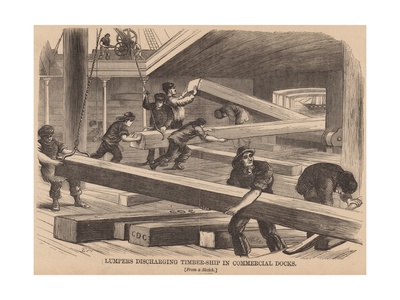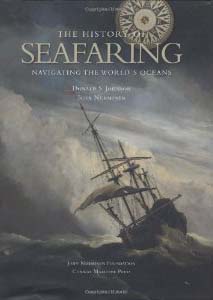Ship Captains: San Francisco 1800s
Charles Boudrow
1830-1918
Charles Boudrow was a Massachusetts-born master mariner who for many years was a shipping magnate in San Francisco. Boudrow was a principal stockholder of The California Shipping Co. which was organized by William A. Mighell of San Francisco, who became president and manager of the firm. In 1900, The California Shipping Co. was rated as the most extensive owner of sailing vessels in the world. Other principal stockholders included W. J. Gray, Roth, Blum & Co., Charles Boudrow, John Dolbeer, Bennett & Goodall, E. Kentfield, and Pope & Talbot.
A number of individuals and firms prominent in the shipping industry of the Pacific Northwest and San Francisco, combined as the California Shipping Co., purchased one of the world's largest sailing vessels, the 3,340-ton May Flint upon her arrival at Tacoma from Hong Kong in March. Her voyage was an extremely slow one, fears being entertained for her safety and reinsurance quoted at eight per cent. An iron vessel, built originally at Dumbarton in 1880 as the steamship Persian Monarch, the May Flint, rigged as a fourmasted bark, was capable of carrying about twice the cargo of the average British sailing vessel of the Northwest wheat fleets.
Captain Boudrow s office was located near the port of San Francisco, at 38 40 Market Street. His residence was not far from there, at 1933 Stevenson Street.
Living near him (but never with him) both in San Francisco and in Berkeley was his nephew Charles E. Boudrow, a ship chandler and dealer in ship material born in Massachusetts in 1858. The nephew s major claim to fame was his purchase of the decommissioned sloop-of-war Marion from the U.S. Navy in July 1907. He moved to Berkeley at about the same time as his uncle and first appeared in the 1891 directory living on Spruce Street between Vine and Rose. Beginning with the 1893 directory, the younger Boudrow s residence was 1432 Arch Street, where he remained for many years. In 1894 and 1895 he lived with Miss Louisa F. Boudrow.
November 9, 1899, San Francisco Call, San Francisco, California, U.S.A.
New Shipping Company
Local Business Men Will Compete for Trade of the Orient.
The California Shipping Company incorporated yesterday with a capital stock of $1,000,000, of which $800,000 has been subscribed. The subscribers are: W. E. Mighell, $34,000; Charles Boudrow. $17,000; John Dolbeer, $18,000; G. M. Josselyn & Co., $7000; Edward W. Kentfleld. $68,000: William Babcock, $50,000; Emma I. York. $8,000; Louis Schwabacker, $10,000; Sigmund Schwabacker, $10,000; Roth, Blum & Co., $21,000; George Jennings, $17,000; Kirkham Wright, $17,000; W. J. Gray, $17,000; Antone Borel & Co., $25,000; N. D. Rideout. $25,000; Arthur L. Black, $5,000; Charles Nelson, $5,000; Henry F. Allen, $25,000; Hind, Rolph & Co $10,000; Moses Blum, $10,000; Bennett & Goodall, $17,000; F. W. Zeile, $10,000; H. L. E. Meyer, $25,000; Pope & Talbot, $25,000; William Haas, $10,000; John C. & E. Coleman, $25,000: J. G. Lavensaler, $,5000; Austin C. Tubbs, $17,000; Fireman's Fund Insurance Company, $25,000; Oliver R. Chapman, $20,000; Carter P. Pomeroy, $3,000; George H. Foster, $2,000; W. S. Jones, $5,000; A. Himmelman, $2,000, and W. E. Mighell, trustee, $10,000.
December 22, 1901, San Francisco Call
Charles Boudrow Steals March and Becomes a Benedict.
BERKELEY, December 21. Captain Charles Boudrow, vice president of the California Shipping Company and a well known master mariner, has just returned from Seattle with a bride. The captain left his Berkeley home two weeks ago for a trip to the north, ostensibly to attend to some of his business interests, but in reality to meet Miss Christina Herman, who came across continents and seas from her home in Vienna, Austria to marry him. Captain Boudrow's stolen march and romance is the talk of his friends in social and commercial life, for he kept his Intentions secret.
Years ago Captain Boudrow and his bride met at the young woman's Vienna home. They maintained a correspondence, although far apart, which finally culminated in a betrothal. As the mariner could not spare the time to go to his bride-to-be it was agreed that she should come to America. Instead if coming to California the young lady made Seattle her destination, and the gallant captain found it convenient to be there to meet her. A wedding took place shortly after the meeting. The intervening time has been spent in a honeymoon.
Captain Boudrow has been identified with shipping interests on this coast for a long time and is considered quite wealthy. His handsome residence at 1535 Oxford street is surrounded by the finest grounds in the city.
January 13, 1907, San Francisco Call
When the Burning of Great Ships Made a Night-Time Carnival
Hanna Astrup Larsen
. . . It seems strange to speak of the destruction of ships as a profitable industry, but it has been a distinct industry and a very profitable one. It is not so any longer, owing to the fact that cast iron has replaced the copper which formed a large part of the makeup of the old vessels, and which made it worth while to go to a great deal of trouble for the sake of getting it out. Then, too, copper was more valuable in those days than it is now.
Mr. C. E. Boudrow, who, with Captain Charles Boudrow and his two partners Gibson and Clancy, was-for many years engaged in the business of breaking up old ships, has in his Berkeley home a collection of relics from many of the most famous ships that have been on the Pacific Coast, all of which have been broken up and burned for junk. There are canes made from the timbers of condemned warships, articles manufactured from the brass bearings of the machinery, silver and furniture from elegant passenger steamers.
The company began business in Boston by buying old steamers of the Pacific Mail Line running between New York and Aspinwall. These were usually towed from New York to Boston and broken up in Boston harbor. Sometimes the breaking up took place in New York.
In 1877 the company moved to the Pacific Coast and began operations by buying two of the Pacific Mall steamers on this side, the Arizona and the Montana. The Oriflamme and the John L. Stephens of the Ben Holladay line came soon after. The Constitution and the Colorado were bought at a great cost and their remains were added to the rubbish heap after extracting all that was valuable from them, seven warships left their ashes with the rest.
|
Mr. Boudrow has in his house canes made from the timbers of the following ships, all of which were broken up at Tiburon: The Alaska, the Tuscarora, the Benicia, the Nyack, the Saco and the Narragansett. He has also a tiny anvil cast of brass from the machinery of the Narragansett, which, he uses as a paper weight, and a small brass cannon from the machinery of the Monadnock the original Monadnock of Civil War fame. Another memento from the Monadnock is in the possession of Captain Boudrow. It is a small round brass table resting on three eagles' claws and bearing an inscription stating that it was made from the brass bearings of the monitor Monadnock, together with the captain's name and the date on which the vessel was broken up.
The big double-turreted monitor was a tough customer. The condemned ships were all taken first to Hunters Point, where the machinery was taken out of them to be broken up for scrap iron. Then the hulls were towed to Tiburon and burned there. But the Monadnock, being made entirely of iron plates, had to be picked to pieces bit by bit. She bore the marks of cannon balls that had penetrated and shattered three of the nine one-inch armor plates of which she was made, leaving the other six intact. The plates were fitted solidly one to the other, and the attempt was made to force them slightly apart so that it should be possible to get powder in between and blow them apart, but this was found impracticable. The iron in the immediate vicinity of the powder would have been shattered, leaving the rest of the plates intact, and it became necessary to take the rivets out one by one in order to separate the plates, which were then broken up in marketable lengths of not more than four feet. Foundries were not so large in those days as they are now.
All the other vessels destroyed were of wood, and the burning of them was a gala day in the neighborhood. The company had rented the beach in Tiburon Cove from Mr. Kewshaw, who claimed that as well as what was known as Kershaw's Island, now Belvedere. This was in the days when Tiburon was not, except as a cove, surrounded by dark green wooded hills, a stretch of marsh all red and yellow in the sunlight, and a sandy beach lapped by the bright, blue waters.
Made a Glorious Blaze
When a ship was to be burned word was sent to the neighborhood; and, even if the message should have been forgotten, the first red flame reflected in the sky was the signal for people to sally forth. There were no ferries or railroads to bring spectators from afar, but from the surrounding ranches they came on foot and on horseback, gathering on the hills to see the blaze. From Sausalito they came in yachts and rowboats, covering the bay like a flock of seagulls.
The ship was towed as near as possible to the beach. Sometimes, in the case of the largest ships, it was necessary first to divest them of the cabins or upper deck in order to get them into the cove. When darkness had settled over land and water, when the hull loomed black and shadowy in the night, while the hushed expectancy of the spectators had almost reached the breaking point, then the workmen who had gone on board the ship lit a fire in two or three places in the hold. They made a rush for the open air, pursued by smoke and flame, for the dry pine timbers burned like match boxes. Instantly there was a roaring of the flames, chasing like fighting armies back and forth, round and round seeking an escape. Volumes of tawny smoke poured out of the hatches, tongues of flame licked the edges. Then suddenly the ship was one blaze from the water's edge while above the sheet of flame writhed and curled and hissed the serpents of fire that seemed to touch the very sky. The country for miles around was as light as day, while against the blackness of the water the blaze was multiplied by reflection in the nearer ripples.
And so the old ship died in a blaze of glory, game to the last, and even in her death made a holiday for the whole bayside.
When the fire had done its work the ship's bottom was towed on the beach and there is even now a mast to be seen almost buried in the sand which was used to secure the heavy purchases that did the work. The remains of the hull were chopped into pieces and burned to get the copper out. Copper fastenings were used entirely in those days, and the warships were always strengthened by copper bolts fully fourteen feet long and two inches thick.
Before setting fire to them, the ships were stripped of their rich furnishings. Doors and panels from the liners still linger in the old houses of Tiburon, and if one could canvass among the old-timers of the little place, many articles of furniture from the old shops would no doubt come to light.
The most palatial of all the ships broken up was the John L. Stephens, often called Ben Holladay's yacht, because the owner was said to have fitted her out for his personal use. The walnut bed and rich upholstered furniture of the owner's private stateroom were used by the Boudrows to furnish their little cabin on the beach, where they lived while superintending the work . . .
The last vessel which was only partly broken up at Tiburon was the mail steamer China. Its large and elegant cabin was lifted off the deck and sold for a residence. It is now one of the swell residences in old Tiburon . . .
On 8 June 1918, the Oakland Tribune published Captain Boudrow's obituary, stating:
"Captain Charles Boudrow died suddenly at his home in Berkeley last night. He passed his 88th birthday a few months ago and was then well and hearty. Boudrow was connected with the firm of Migeul (correct spelling: Mighell) & Boudrow, which owned many large square-riggers out of this port, later forming the California Shipping Company and purchasing many eastern craft, which are owned by the Alaska Salmon companies. He retired from active service a few years ago, but made regular visits to the Merchants Exchange to talk ship with his old-time friends. For over 60 years Boudrow had been established in the marine business in this port."
Editor's Note: Additional information on Captain Boudrow's life, including photographs of the classic home built in Berkeley by the Captain, are to be found on the Berkeley Architectural Heritage Association (BAHA), which is well worth a visit.
The Sea Chart
The Illustrated History of Nautical Maps and Navigational Charts
John Blake
The sea chart was one of the key tools by which ships of trade, transport and conquest navigated their course across the oceans. John Blake looks at the history and development of the chart and the related nautical map, in both scientific and aesthetic terms, as a means of safe and accurate seaborne navigation. This handsome work contains 150 color illustrations including the earliest charts of the Mediterranean made by thirteenth-century Italian merchant adventurers, as well as eighteenth-century charts that became strategic naval and commercial requirements and led to Cook's voyages in the Pacific, the search for the Northwest Passage, and races to the Arctic and Antarctic.












 Copyright ~ 1998-2018.
Copyright ~ 1998-2018. 